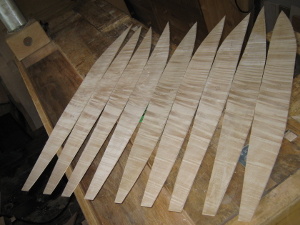
Dodd Lutherie specialises in the construction of lute family instruments and is the home of lute-makers Adrian Dodd and his son Lawrence.

Having had a lifelong love of renaissance and baroque music, a particular fondness for the sound of the plucked string, and having worked in the decorative arts and with wood for nearly thirty years, Adrian made his first lute in 2007. This first instrument was, as with his other passion for painting in oils, a product of intense self-study. Shortly afterwards however, Adrian augmented and developed his own methods by building several instruments under the guidance of David Van Edwards' highly successful published renaissance and baroque lute making courses.
Before making lutes Adrian had a career as a commercial sign-writer having served as an apprentice and trained in a variety of skills within that old workshop tradition. All manner of decorative work was undertaken drawing on skills such as brush-writing, water and oil gilding, marbling, pictorials, and decorative woodwork such as mouldings and carved lettering. Adrian later supplemented these skills by engaging in the self-study of oil painting (two examples of his painting can be seen on this page and further examples are displayed in the Painting Gallery).
Lawrence has been taking an active interest in lutes and lute making for almost as long as his father and has been recently increasingly involved in all aspects of lute construction, design, research and even web-building within the business. He has a deep love of music going back to childhood and has played piano since the age of seven, later took up playing the harpsichord and in more recent times started playing the baroque lute.
It was the harpsichord that first inspired both Lawrence and his father to try their hands at instrument making. Eager to play but unable to remotely afford a working harpsichord Lawrence obtained a small Italian style instrument in need of serious re-constructive/restorative work. Reading widely on the subject of harpsichord building Lawrence undertook with the help of his father the restoration of this neglected instrument over one summer. Spurred on by great success he then obtained the casework for a large single-manual harpsichord and proceeded to perform a complete re-design and rebuild to make it into a double-manual instrument. These instrument building successes, combined with Adrian's by now developing interest in the lute, inevitably contributed to Adrian making his first lute.
Lawrence has also studied Analytic Philosophy at the University of Nottingham achieving both a First-class honours degree and an MA Passed with Distinction.
We feel that our instrument making is an extension of other artistic endeavours. It is the challenging nature of instrument making that is so satisfying, the necessity for balance, the drawing of visual and acoustic aesthetics together and ultimately the making of a playable tool that other artists can create music with.

We only use natural hide glues in our instruments and prefer to use traditional woods. Occasionally more unusual woods may be used for lute backs but generally we try to use woods and grains appropriate to a given historical school of lute making. The lutes are modelled on both surviving historical lutes and iconography, and principles of proportion are utilised throughout and during construction.
Given the small difference in the cost of higher and lower grades of soundboard relative to the overall cost of labour we always use a high grade Alpine spruce. Soundboards are carefully thinned and barred in a way that we feel is appropriate for the model, historical period and purpose of the instrument. All the while particular attention is paid to the tap tuning of the soundboard. Roses are all based on those found in extant lutes or iconography.

Unless a lute is constructed out of an especially hard oily wood, for example rosewood, a coloured oil varnish is always used.
Pegs are all turned by hand (no pattern cutting) in-house, this allows for a very subtle and attractive tailoring of the sizes of lute pegs to the tapered form of the pegbox as seen on historical instruments. The woods we use most commonly for this purpose are boxwood and plum, both of which are particularly stable woods and excellent for this purpose. Box has a lovely buttery colour in keeping with the aesthetic of earlier periods. Plum on the other hand is almost, though not always, blackened. Bridges are usually plum and occasionally walnut on Baroque lutes.
We prefer not to release an instrument immediately upon completion. This is because we feel that allowing the instrument to settle for a short while, hear its developed sound, check that pegs run smoothly after a little use etc. is an integral part of the building process.
For further details please consult the catalogue and price list. Alternatively, please do not hesitate to contact us, we are very happy to discuss individual requirements (e.g. string spacing at bridge and nut, action, materials etc.) or answer general queries.

